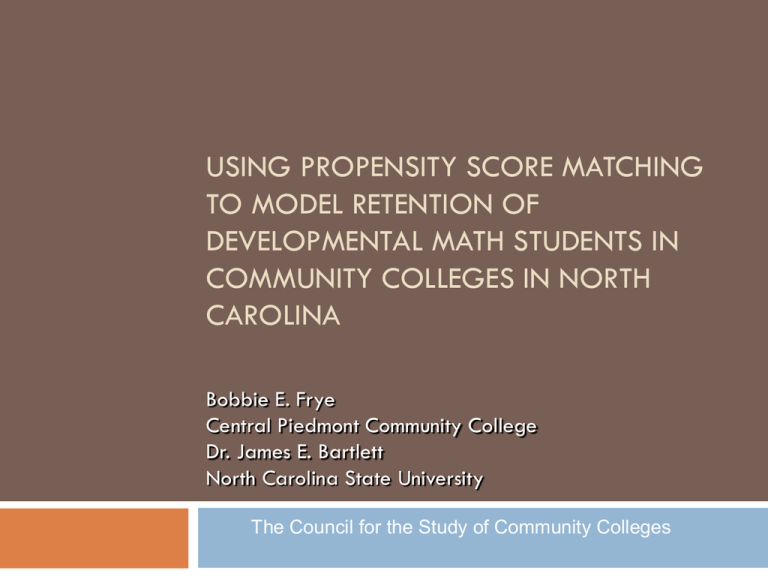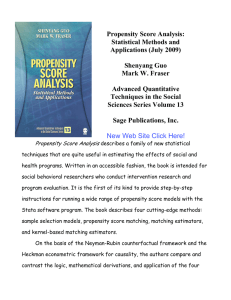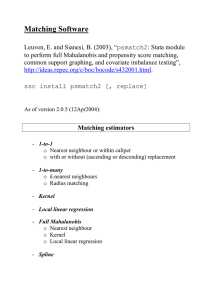CSCC Presentation: Using Propensity Score Matching to Model Retention of Developmental Math Students in Community Colleges In North Carolina-
advertisement

USING PROPENSITY SCORE MATCHING TO MODEL RETENTION OF DEVELOPMENTAL MATH STUDENTS IN COMMUNITY COLLEGES IN NORTH CAROLINA Bobbie E. Frye Central Piedmont Community College Dr. James E. Bartlett North Carolina State University The Council for the Study of Community Colleges Agenda Introduction Statement of Problem/Purpose Research Questions Theoretical Framework Methods Analyses Results Contributions Conclusions Future Research Introduction Remedial [developmental] courses are a fixture in the American community college • Allow students that are not prepared for college level work to enroll in college programs • Annual cost of remediation: 1.9 – 2.3 billion dollars Placement in developmental course • Varies by institution (i.e. Placement scores, Prerequisites, Statewide policies, Program requirements, etc.) Remedial Evidence • Achieving the Dream (ATD) a national community college student success initiative which targets low income and under-represented populations, found that 62% of fulltime students in community colleges needed developmental math. • Data analyses of ATD colleges have revealed consistent patterns of entering students who require developmental education, and who experience low completion rates in developmental courses (ATD, 2010). • A National Educational Longitudinal Study (NELS) followed 8th grade students from 1988 to the year 2000, and found that 58% of those students who attended a community college took at least one remedial course, 44% took between one and three courses, and 14% took more than three remedial courses (Attewell, Domina, Lavin & Levey, 2006). Nature of Problem Developmental math education: it’s a gauntlet that many students run but few students (25%) emerge from successfully (Bailey, 2009, Clery, 2009). About 60% of new students place into developmental math (Bailey, et al., 2010). “Though a primary point of access to higher education, community colleges struggle to ensure that all of their students earn a credential” (Kolenovic, Linderman, & Karp, 2013, p.272). In addition to financial costs, there are social and personal costs for students who move through the developmental education sequences (Bailey et al., 2010). Past Research The studies have methodological limitations to particular states and sub-populations of students. Failure to control for selection bias is a common concern in the study of developmental education (Bettinger & Long, 2005). So far, results have been mixed. Statement Of Problem Researchers acknowledge the limitations of comparing student performance, progression, or retention in a non-scientific study wherein participants are not randomly assigned nor even equivalent in terms of motivation, intentions, background, or skill level (Titus, 2007). Comparisons of student outcomes using propensity matching has been used to yield less biased results than are derived using simple raw comparisons (Rojewski et al., 2009). Proposed remedies to self-selection bias in educational research need to be explored in terms of feasibility and usefulness, as it is critical that researchers apply methodologies that control for selection bias. Resources are scarce and monies need to be allocated to educational programs that are making a difference in students’ success, retention rates, and long-term outcomes. What is the Purpose? The purpose of this study is to determine if there is a significant difference in characteristics and college level outcomes between developmental math students who complete college math coursework compared to students who do not complete math coursework. Students referred to developmental math are the participants, defined as students referred into one or more areas of developmental math coursework and enrolled in at least one developmental math course during the study period. The population consists of 2007-08 new student cohorts at seven NC community colleges. Purpose The purpose of this study was to determine if there is a difference in outcomes of grade point average, credits earned, credentials earned, transfer, and retention between two groups. Comparison Group: Group of students who complete developmental math coursework, attempt but do no complete college level math with a C or better Study Group: Group of students who complete developmental math coursework and subsequently college level math with a C or better Propensity matching was used to create two equivalent groups of students matched on the propensity to complete college level math Research Questions Prior to propensity matching, is there a difference in student and academic characteristics between developmental students who complete college math coursework compared to students who do not complete math coursework? Prior to propensity matching, is there a difference in student and academic characteristics between developmental students who complete college math coursework compared to students who do not complete math coursework between institutions? After propensity matching, is there a difference in college level outcomes between developmental students who complete college math coursework compared to students who do not complete math coursework? After propensity matching, is there a difference in college level outcomes between developmental students who complete college math coursework compared to students who do not complete math coursework between institutions ? Theoretical Framework – 10 Student retention theories Tinto – Academic and social integration Behaviors (1993) Bean and Metzner Academic integration and environmental factors – Beliefs (1995) Four Models Examined Variable Name Gender Age Race* Transfer Program Pell Recipient Full-Time in 1st Term First Dev. Math Level Retained 2nd term Dev. English Success Course First Term GPA % Minority** % Pell Recipients** % Dev. English *** % Dev. Math *** Institution Member Model I Student Demographics X X X X X X X Model II Academic Integration X X X X X X X X X X X Model III Individual & Institution X X X X X X X X X X X X X X X Model IV Individual & Institution X X X X X X X X X X X X *Race categories: White, African American, Hispanic, International, Asian, Other ** Number of students as a percentage of fall 2007 enrollment ***Number of students as a percentage of 2007-08 institutional FTE Methods Non-Experimental (Propensity Score Matching) Study Group 5,548 students who placed into developmental math coursework and of those 2,102 (38%) of students who subsequently attempted college level math Purposeful sampling technique Variables Matching variables-Independent Grouping (Variable-A-C Completion/Non-Completion College Math) Dependent (Student Outcomes) Data Collection- Student term records Fall 2007-Summer 2012 Data Analysis Multi-Level Propensity Score Matching There are six essential steps to PSM: Data pre-screening Covariate identification Propensity score estimation Matching of propensity scores Determination of matching success Presentation of results Analyses To analyze whether there is a difference in demographics and academic characteristics of the two study groups prior to propensity score matching t-tests will be used. Means, standard deviation, significance levels of p<=05, t values and cohen’s d (effect size) will be reported using t-tests analyses (Rojewski, et al., 2009; 2010). Bias percentages (standardized effect sizes) before and after matching were also reported (Oakes & Johnson, 2006). The standardized percent bias is the percent difference of the sample means in the treated and non-treated (full or matched) sub-samples as a percentage of the square root of the average of the sample variances in the treated and non-treated groups (Rosenbaum & Rubin, 1985) Logistic regression will also be used to determine the background and academic factors that explain membership in the two groups of study and to create a propensity score that is used in the matching technique. Logistic stepwise regression will yield significant independent variables that predict membership in the control or treatment groups. Nakelkerke R-squared, chi-squared, beta coefficients and independent variables with p value <=.05 were reported and retained in the model (Rojewski, et al., 2009; 2010). Using the propensity score generated through the logistic regression technique, equivalent groups of students were propensity matched using a matching procedure in STATA software (Titus, 2007). The technique known as psmatch2 creates two matched groups based on the propensity to complete college level math. Logistic Regression Results (Sig. prior to Match) Covariates Model I Model II Model III Model IV DV: Complete CL Math Exp(B) Exp(B) Exp(B) Exp(B) 1.411** 1.369** 1.377** 1.345** Gender (Female) Age 1.018* African American 0.532** 0.607* 0.487*** 0.484*** Pell Recipient 0.736** 0.736** 0.756* 0.754* 1.235*** 1.254*** 1.235*** % Minority 1.055*** NA % Pell Awarded 0.945* NA % Dev English 0.914* NA First Term GPA College B 1.350* College F 2.963*** College G 0.459*** R-Squared Notes: *p < .05 0.044 **p < .01 0.075 ***p < .001 0.090 0.115 Model IV T-Tests Prior to Matching (Sig. variables) Covariates Gender White African American Pell Dev. Eng. 1st Term GPA N M SD t p d % bias 539 0.516 0.500 2.687 0.007** 0.133 13.400 1,563 0.582 0.493 539 0.497 0.500 4.370 0.000*** 0.218 21.700 1,563 0.605 0.489 539 0.319 0.200 -6.520 0.000*** -0.309 -31.100 1,563 0.186 0.009 539 0.359 0.480 -3.530 0.000*** -0.172 -17.300 1,563 0.280 0.449 539 0.471 0.499 -4.140 0.000*** -0.206 -20.500 1,563 0.370 0.483 539 2.07 1.473 7.750 0.000*** 0.382 38.300 1,563 2.62 1.406 Model IV T-Tests Prior to Matching (continued) Covariates N M SD t p d % bias College B 539 0.345 0.475 2.410 0.016* 0.122 12.100 1,563 0.404 0.490 539 0.043 0.202 5.740 0.000*** 0.320 31.800 1,563 0.131 0.338 539 0.134 0.341 -4.690 0.000*** -0.219 -21.700 1,563 0.068 0.253 College F College G Average Bias R-Squared Cohen’s d = Mt – Mc / σpooled; where σpooled = √ σ2t + σ2c / 2 *p < .05 **p < .01 ***p < .001 First line of each variable is the control group; second line is the treatment group. 13.400 0.072 Model IV T-Tests After Matching Covariate Gender Age White African American Hispanic Transfer Pell N M SD t p d % bias 512 0.525 0.500 -0.527 0.598 -0.032 -3.700 507 0.509 0.500 512 21.529 6.992 -0.750 0.453 -0.047 -4.800 507 21.219 6.189 512 0.510 0.500 -0.217 0.828 -0.014 -3.300 507 0.503 0.500 512 0.297 0.457 0.307 0.759 0.020 5.300 507 0.306 0.461 512 0.048 0.215 -0.728 0.467 -0.044 -4.400 507 0.039 0.195 512 0.465 0.499 -0.231 0.817 -0.014 -1.000 507 0.458 0.499 512 0.346 0.476 0.835 0.404 0.052 7.200 507 0.371 0.483 Model IV T-Tests After Matching (Continued) Covariate Full-Time First Dev. Math Dev. Eng Success 1st Term GPA Retained to 2nd N M SD t p d % bias 512 0.656 0.475 0.351 0.725 0.023 2.600 507 0.667 0.472 512 1.984 0.735 0.256 0.798 0.016 1.400 507 1.996 0.722 512 0.453 0.498 0.206 0.837 -0.012 3.900 507 0.459 0.499 512 0.359 0.480 -0.342 0.732 -0.021 -0.900 507 0.349 0.477 512 2.141 1.460 -0.609 0.543 -0.038 -7.200 507 2.084 1.556 512 0.901 0.300 -0.156 0.875 -0.013 -1.200 507 0.897 0.304 Model IV T-Tests After Matching (Continued) Covariate N M SD t p d % bias College B 512 0.359 0.480 -0.541 0.589 -0.034 -4.200 507 0.343 0.475 512 0.051 0.220 -0.556 0.578 -0.038 -4.600 507 0.043 0.204 512 0.008 0.088 -0.070 -0.366 -0.024 -2.200 507 0.006 0.077 512 0.043 0.203 -0.123 0.902 -0.010 -1.500 507 0.041 0.199 512 0.049 0.207 -0.597 0.550 -0.060 -3.200 507 0.037 0.190 512 0.121 0.326 0.430 0.667 -0.028 0.400 507 0.112 0.316 College C College D College E College F College G Average Bias 3.300 R-Squared Cohen’s d = Mt – Mc / σpooled; where σpooled = √ σ2t + σ2c / 2 *p < .05 **p < .01 ***p < .001 First line of each variable is the control group; second line is the treatment group. 0.063 Summary Before and After Matching Bias Pre Bias Post %Change R2 Pre R2 Post Change Sig. CV’s Pre Sig. CV’s Post Change Model I 10.4% 10.3% -0.9% 0.020 0.041 +0.021 4 3 -1 Model II 12.5% 4.20% -66.4% 0.046 0.040 -0.006 6 0 -6 Model III 13.0% 2.80% -78.5% 0.061 0.050 -0.011 8 1 -7 Model IV 13.4% 3.30% -75.4% 0.072 0.063 -0.090 8 0 -8 Final Analyses After matching, to determine if there a difference in college level outcomes between developmental math students who complete college math coursework compared to students who do not complete math coursework, T-Tests were used. Means, standard deviation, significance levels of p<=.05, t values and cohen’s d were reported using t-tests analyses (Rojewski, et al., 2010). Completion outcomes were categorical and chi-square analyses were used to determine the measures of association between the students who completed college math coursework compared to students who did not complete math coursework in terms of completion categories (Rojewski, et al, 2010). Model IV T-Tests Outcomes after Matching College Courses N Credits Attempted Credits Completed M SD t 512 51.259 27.090 507 67.852 25.406 512 31.516 23.827 507 55.884 23.447 512 26.750 21.654 507 51.525 22.511 512 6.139 2.785 507 7.524 2.576 p d 10.083 0.000*** 0.632 16.453 0.000*** 1.031 17.905 0.000*** 1.122 8.245 0.000*** 0.516 Credits A-C Retention Terms Retained Model IV T-Tests Outcomes after Matching Outcomes Developmental Courses Credits Attempted Credits Completed Credits A-C Developmental Math Credits Attempted Credits Completed Credits A-C N M SD t 512 13.504 8.894 507 13.191 8.761 512 10.080 7.133 507 11.087 7.673 512 9.402 6.834 507 10.368 7.258 512 8.101 4.603 507 7.854 4.470 512 5.906 3.752 507 6.379 3.652 512 5.398 3.469 507 5.826 3.295 p d -0.565 0.572 -0.035 2.169 0.030* 0.136 2.189 0.029* 0.137 -0.871 0.384 -0.054 2.036 0.042* 0.128 2.019 0.044* 0.126 Model IV Completion Outcomes Completion Categories No Outcome Associate/Certificate Transfer 2 Year Transfer 4 Year Still Enrolled 30 Plus Credits Total Total Alpha= 0.050 Chi-Squared= 165.159 Degrees of Freedom= 4 p value < .001 Cramer’s V= 0.403 Passed CollegeLevel Math Grade of C or Better Observed 133 Expected 226.4 Observed 81 Expected 51.7 Observed 44 Expected 30.4 Observed 177 Expected 124.9 Observed 72 Expected 73.6 Row Percent 29.23% Not Passed CollegeLevel Math 322 Row Percent 70.77% 228.6 77.88% 23 17 22.12% 74 27.87% 76 29.48% 251 251.0 51.35% 74.4 49.75% 61 61.0 126.1 48.65% 104 104.0 30.6 70.52% 455 455.0 52.3 72.13% Total 148 148.0 50.25% 1019 Conclusions After matching, the average means differ between the two groups on key progress indicators. Specifically, the study group fared better than the comparison group and completed, on average, 25 more college credits at the community college. In addition, the study group was retained an average of 1.5 more semesters than the comparison group. Conclusions (Continued) In terms of expected versus observed frequencies, a higher number (71%) of students in the non-completion group earned no award compared to students in the completion group. Completers of college math with C or better earned significantly more associate degrees (78%) than noncompleters. However, in the four models, non-completers of college level math were twice as likely to earn no outcome after five years when compared to the completer group. Transfers to four-year and two-year institutions were common in both groups of students, and the math completion group was twice as likely to transfer out of the institution. Contributions Applied propensity score matching methods across multiple community colleges Demonstrated that students did not differ to a large extent Demonstrated that propensity matching reduced the bias at least 75% for the multi-level model Demonstrated the need to conduct additional research and examine variations among colleges Significance of Study The proposed study examines a state that has received little attention in the literature. Contributes to program evaluation by using a propensity score matching multivariate approach. Examines institutional variance utilizing a multi-level propensity matching methodology. Relevant to the math redesign efforts and broader developmental education reform. Limitations No research methodology is free of bias (Bostian, 2008). The propensity score method reduces the number of cases through the matching procedure. The elimination of cases occurs during the matching process when a match is not found based on the propensity score (Caliendo & Kopeinig, 2008). While the colleges range in size from small, medium to large student populations, there is no indication that the colleges are representative of most community colleges. Some important variables found to be significant indicators of student success, are not available in the dataset and introduce the potential for unobserved differences. (Gelman & Hill, 2007). Future Research Future research is needed to examine sensitivity to missing data among the various techniques utilized in multi-level propensity score research (Kim & Seltzer, 2007). Future research is needed to provide guidance about adequate sample sizes in multi-institutional studies. Future research should explore the timing of developmental math courses and college-level math in order to provide policy guidance to community colleges currently revising advising models. Future qualitative research examining institutional variation is needed to help explain the contextual variation that yielded different outcomes for students within institutions. Questions

